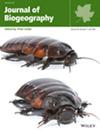Stream Co-Occurrence Networks Depend on Spatial Extent, Environmental Conditions and Organismal Group
Abstract
Aim
Co-occurrence networks can be described in terms of topology (i.e., size and connectance) and node degree distribution (NDD). The NDD represents the frequency distribution of nodes (species) with k number of connections (degree). The shape of the NDD, single-scale, scale-free (power-law) or broad-scale, reveals if there are species with many connections to other species (high-degree nodes), which may have important ecological functions. However, it remains unknown how spatial extent and environmental conditions impact network topology and the NDD shape and whether these relationships depend on species dispersal capacity.
Location
Continental United States of America.
Taxa
Stream diatoms and fish.
Methods
We constructed landscape windows ranging in spatial extent from 160,000 to 2,560,000 km2. For each window, we calculated environmental heterogeneity and median environmental conditions and generated correlation-based co-occurrence networks. We evaluated the topology and NDD shape of each network. To each NDD, we fit six statistical models, classified as single-scale, power-law or broad-scale. Contingency table analysis, redundancy analyses and variance partitioning tested the sources of variability in network topology and/or NDD shape.
Results
The NDDs were almost exclusively fit either by single-scale + broad-scale models or broad-scale models. As spatial extent increased, network size increased, connectance decreased, and the NDD shifted in an organism-specific manner. In both groups, network responses to spatial extent were attributed primarily to variability in climatic heterogeneity followed by urban development in diatoms.
Main Conclusions
Spatial extent determined co-occurrence network properties primarily via climatic and land use factors. Broad-scale NDDs, indicating the presence of high-degree nodes, were more common in the well-dispersed diatoms than in the more poorly dispersing fish. Furthermore, these NDDs increased in frequency with spatial extent and climatic heterogeneity in diatoms but decreased in fish. High-degree nodes are likely climatic generalists in diatoms but keystone or more dispersive species in fish.

 求助内容:
求助内容: 应助结果提醒方式:
应助结果提醒方式:


